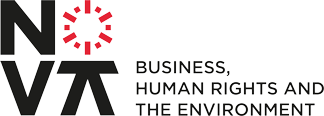This post is based on the opening speech of Dussu Djabula in the first “Annual Conference on Business, Human Rights and Sustainability” organised by the Nova Centre on Business, Human Rights and the Environment with the support of PLMJ, the Portuguese Chamber of Commerce and Industry, CEDIS, as well as NOVA 4 The Globe on the 24th of November 2021.
About the author: Dussu Djabula is a Research Assistant at the Nova Centre on Business, Human Rights and the Environment. Dussu is part of the research line “Business, Human Rights and Non-Judicial Remedies”.
There is a need to discuss Climate Change and Human Rights through an intersectional lens. This particular theme is of utmost importance, and it has been brought even further to the spotlight with COP26, but also with alarming data that shows how Climate Change is one of the leading causes of the aggravation of food insecurity.
While COP26 was taking place, much was said, and even criticized. Many share the belief that COP26 was never meant to be successful. There are many reasons to state that indeed COP26 was a failure, the changes done at the eleventh hour and the reluctance to name fossil fuels has one of the core issues are a clear example of how there is still much to be done in order to avoid a catastrophic and irremediable disaster. Regardless of this, it is to note that from COP26, much still happened:
– 40 countries pledged to phase out coal, the most polluting fossil fuel, and members of this pledge include heavy coal users. Richer countries said they would phase it out in the 2030s, with poorer countries committing to the 2040s.
– Many world leaders agreed on a UK-led plan to accelerate affordable and clean technology worldwide by 2030.
– The EU has launched a programme to finance climate innovation alongside Bill Gates and the European Investment Bank.
– 45 countries have pledged to take urgent action to make farming more sustainable.
Although these commitments are important, they focus on reducing our carbon footprint and little to no discussion has been had about the implications that Climate Change will and already has on Human Rights. Climate Change and Human Rights for a long time have been seen as separate issues, but I challenge you to not see it as separate, but rather as intrinsically connected.
Given the fact that most have already accepted the inevitability of Climate Change, I suggest that we now start having meaningful discussions about what does Climate Change mean to some groups of people, and how the commitments made during and after COP26 might not be capable to address the complexity of the issue.
Kimberlé Crenshaw, the Professor who coined the term “intersectionality” defines it as “a prism for seeing the way in which various forms of inequality often operate together and exacerbate each other”. Intersectionality can and should be an overarching concept and idea that when applied to our societal issues enable us to reach solutions that don’t leave behind the most marginalized groups of people. This is why I would like to briefly explore the intersection between Climate Change and Race, and, Climate Change and Gender, as a way to avoid a narrow view of what could be a just transition. It is clear to me that we can’t advocate against Climate Change without also advocating for the people who would be most affected in the event of a potential reckless phasing out of fossil fuel.
As Elizabeth Yeampierre states, “With the arrival of slavery comes a repurposing of the land, chopping down of trees, disrupting water systems and other ecological systems”. Racial injustice and Climate Change are deeply connected, which is what activists such as Elizabeth Yeampierre have dedicated much of their life to explore and study. Climate change and racial injustice share the same roots, so they must be addressed together.
Climate change is the result of a legacy of slavery, colonialism, and extraction that helped create and propel what we now see as the greatest danger to human existence. Because of this, it’s not surprising that Climate Change, as the current COVID-19 pandemic, disproportionally affects BIPOC, that is, black, indigenous and other people of colour.
BIPOC are most vulnerable to having flooded homes, vanishing sources of drinking water, disrupted local economies, and extreme heat waves. Wealthy people will and are already anticipating and adapting to Climate Change, while poor and disadvantaged people have less ability to do so, and this inequality has a racial dimension which is made clear by the existing race pay gap. To put this into perspective, recent work done by the think tank GermanWatch found that the 10 countries most threatened by Climate Change are in the Global South and correspond to countries that were in the past colonized.
It is clear that there is a gender dimension to Climate Change, which has been confirmed by the IPCC. Climate Change affects greatly women and girls since it’s likely to put them in dangerous situations where they are more exposed to violence. A report done by CARE shows that one out of five women who are refugees or who have been displaced because of a natural disaster have experienced sexual violence. As if this isn’t alarming enough, there is also a real risk of death of women and girls who are often seen has caregivers. In the case of flooding and other natural disasters, women and girls are expected to stay back and protect other members of their families, which can unfortunately result in their death.
In addition, girls, at a young age, can be forced into marriages as a coping mechanism. After natural disasters the most affected families see young girls as a burden, so in these families’ child marriage is seen as their only option through which they can, on one hand, reduce the families’ economic burden and on the other hand, assure that the girl is taken care of. To illustrate this phenomena better, per example, in Malawi, Climate Change could create 1.5 million additional child brides in the coming years.
All of this, puts into perspective what a just transition could mean. We should look at the outcomes, but also at the process through which we reach carbon-neutral, and the way public and corporate policies are designed to combat Climate Change. To have this just transition, we should have an intersectional perspective, so that when decisions are made there is someone in the room asking “how does this policy affect BIPOC?” and “how does this policy affect women and girls?”. Additionally, we should not only pose those questions, but we should also integrate women and BIPOC in boards as one of the ways to guarantee the success of the fight against Climate Change.
The current commitments made only focus in reducing the impact of Climate Change, and they don’t seek to eliminate and avoid completely Climate Change. If we are going to accept that we can’t avoid Climate Change, then all decisions must be intersectional so that particular groups of people such as women, girls and BIPOC aren’t an afterthought and are thoroughly considered in the process. Setting targets and creating processes without an intersectional lens, I would argue, is worthless. We have the future of a whole generation in our hands, and this, is an enormous responsibility, this is about doing what is right, in the right way. The future starts with the work done in the present.
Disclaimer: There are many intersections at play that go much beyond what was briefly explored in this post.
Suggested citation: D. Djabula, ‘Opening speech: An intersectional perspective on Climate Change’, Nova Centre on Business, Human Rights and the Environment Blog, 9th December 2021.
Latest Posts
Categories
- Annual Conference on Business; Human Rights and Sustainability
- Blogging on B&HR: Towards an EU CSDDD
- Business and Human Rights Developments at the European Level
- Business and Human Rights Developments in Central and Eastern Europe
- Business and Human Rights Developments in Southern Europe
- Business and Human Rights in Conflict
- Business and Human Rights in the World
- Corporate Sustainability Due Diligence Directive
- Exploring new frontiers in the updated OECD Guidelines
- Latest Business and Human Rights Developments
- National Contact Points for Responsible Business Conduct: the road ahead for achieving effective remedies
- Notícias sobre Empresas e Direitos Humanos
- Second Annual Conference on Business; Human Rights and Sustainability
- Serie de blogs “Explorando los caminos hacia el acceso efectivo a la justicia en materia de empresas y derechos humanos”
- Short-Termism in Business Law: A Global Approach
- Sustainability Talks
- Young Voices and Fresh Perspectives

